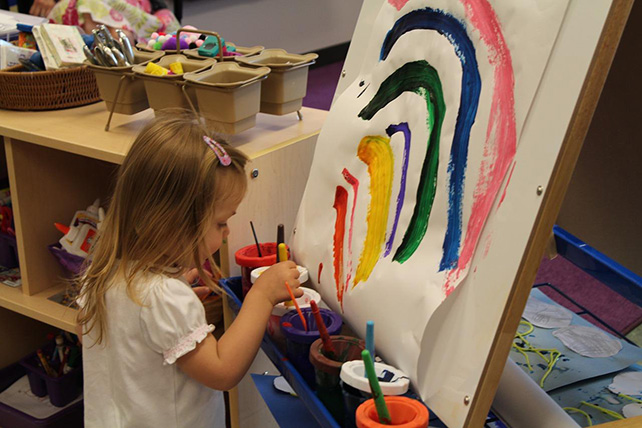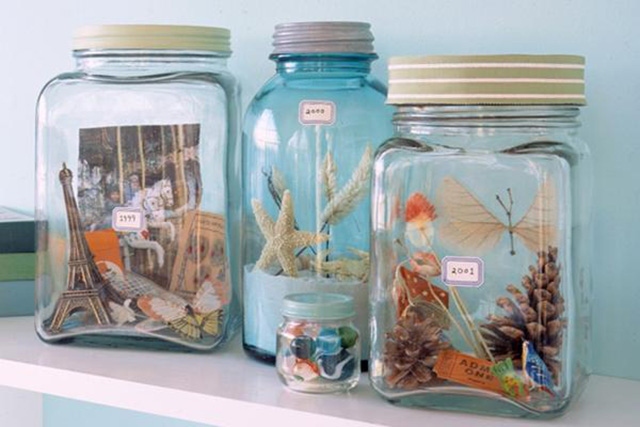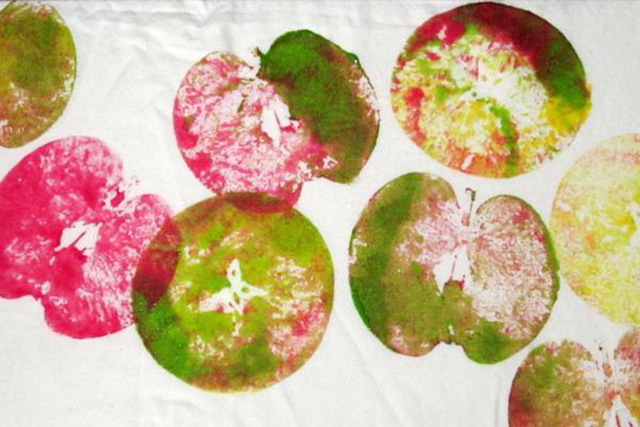
Written by Leigh Marcos
Even though the favored curricula at the overwhelming majority of schools seems to indicate the arts are less important than other subjects such as math and reading, our kids stand to benefit now more than ever from the developmental benefits associated with regular creative engagement with all manner of artistic projects. Kids who have the opportunity to complete art projects on a routine basis tend to enjoy enhanced development in motor skills, language, decision-making, visual learning, inventiveness, and cultural awareness.
Take one of the great masters of art, Pablo Picasso. Picasso began taking lessons from his father at the young age of 7 years old. In the next two years he finished his first painting. At 13 years old, he entered the School of Fine Arts in Barcelona.
Studies have connected regular participation in the arts with superior academic performance, including in core subjects like math and science. Of course, there are many other reasons for working on art projects with your kids, with the most obvious reason being that art projects are always so absolutely enjoyable and represent a wonderful opportunity to strengthen the existing familial bonds.
Whether or not your child is painting the next Van Gogh reproductions or just has a fun afternoon, each of the following nine projects are appropriate for kids of all ages and do not require the use of any hard-to-find or expensive materials. In fact, each one of the projects listed below can be completed with common household items along with inexpensive and widely available materials, with the total cost of each project remaining under $10 in total. That $10 might just be the first dollars spent on a million dollar art career!
1. Oil Paint Reproductions

Kids love seeing their artwork displayed for others to see and you can help guide them in that process! Amazon offers a set of oil paints for $7.50 that will allow you to mimic the “Old Masters” such as Giotto, Da Vinci, Rembrandt, and many more.
If you have an easel, set it up and tape a printed picture of Van Gogh’s Starry Night or any other picture from our site. When your child is done, send us their first name, age and a picture and we’ll feature them on our website!
2. Jungle Dioramas

A brief stroll outside will yield most of the materials needed for making a jungle diorama, and the diorama itself can be housed inside of a simple cardboard box. The following materials should more than suffice for this fun and artistic diorama project:
• Grass, twigs, rocks, and foliage
• Green construction paper
• Acrylic paint
• Woven moss
The jungle animals can be taken from cutouts in any nature magazine, but adding some small toy animals in the diorama will help to create a more three-dimensional effect. To begin, paint the cardboard box with the acrylics to obscure any visible printing and lay the woven moss along the bottom of the diorama. A picture depicting the desired natural setting can be cut from an old magazine and glued to the inside of the box to serve as the background, but you can also create a collage for the background or simply paint your own with your kids.
Once the setting is completed, find a twig just a bit longer than the length of the box and wedge it inside, securing it in place with glue (hot glue works best). For the grass, take a one-inch strip of the green construction paper and fold it lengthwise so you can glue the actual blades of grass to the strip. The strip can be weighed down by rocks or simply glued securely in place. The animal cutouts and toys can now be arranged however you and your kids choose by gluing them to the rocks, sticks, or box.
3. Newspaper Art

Old newspapers are the perfect background material for watercolor or tempera paints, and there is something about the aesthetic of newspaper text that is just fundamentally appealing. A single sheet of newspaper can be affixed to any kind of backing, with a small canvas board being an excellent option. Mod Podge works well to secure the newspaper firmly in place without wrinkling or tearing, but regular glue is effective if carefully applied. Once the newspaper background is applied, the painting options are truly limitless.
For younger children, you may want to trace the outline of a favorite animal with a permanent marker and allow your kids to do the coloring with watercolors or tempera paint. Allowing some of the original newspaper to be visible through negative space creates a nice contrast with the opacity created by the Mod Podge and paints, and this technique can be used over and over again for a multitude of other art projects.
4. Rock Animals

With just a few rocks and some acrylic or tempera paints, you and your kids can undertake a truly unique art project that yields some truly distinctive rock animals. After collecting plenty of rocks and stones of varying sizes and shapes, have your kids pick out the rocks that will best suit the animal they wish to make. It is worth mentioning, however, that the rocks will sometimes dictate the animal that is ultimately created.
Once your kids have all of the rocks they need to create their animal, you can help them glue the pieces together so they remain firmly in place for painting. Once secure, you can add whatever features you choose through the use of paint. A minimalist approach in which eyes and a beak, for example, is often enough to clearly represent the animal, but your kids can be as creative as they like in painting their rock animals.
Rocks and paints can be used for other fun art projects as well, as flat rocks can be made into a set of dominoes or refrigerator magnets and larger rocks can be made into bookends and doorstops.
5. Felt Pinecone Owls

Allow the unique shape of each pinecone to dictate the manner in which your owl presents itself, with a shorter and wider pinecone becoming an inquisitive and curious young owl seemingly leaning forward in anticipation of new information to be learned. A taller and more upright pinecone might become a stately older owl, but each pinecone conveys something different to each individual artist.
This project can be completed with pinecones, felt, and glue, with the felt being used to create the owl’s face and wings. For the owl’s feet, brown pipe cleaners serve as the perfect representation and also create a stable base on which the owl can rest.
6. Treasure Chests

A sturdy shoebox and a few sheets of paper can be quickly transformed into a treasure chest in which you and your kids can store art projects, pictures, or whatever else is deemed worthy of storage within a treasure chest of your own creation. Decorate the exterior of the box in whatever fashion you would like, and then simply accordion-fold a long strip of paper before gluing the first and last pages to the lid of the treasure chest and the bottom of the treasure chest.
When the box is opened and the accordion-folded paper is fully extended, the contents of the treasure chest will be completely revealed. This is a project that you and your kids can add to again and again, as some of the pages can simply be left blank until an item worthy of inclusion within the chest is created or discovered. When the treasure chest is full, a new treasure chest art project can be started all over again.
7. Mason Vacation Jars

A large mason jar or a recycled glass jar is perfect for housing all the trinkets and pictures acquired while on vacation or away on some other exciting adventure. Souvenirs and other representative objects can be lowered and secured in place with a wire bent for this specific purpose along with some glue (the objects do not have to be glued and can be rearranged from time to time). This particular project is a fun and artistic way to document your family’s unique experiences, and it also serves as a way to be more mindful and thoughtfully engaged during your family’s travels together since you will all be thinking about a potential theme for the mason vacation jars you will be working on upon your return home.
8. Pasta Figurines

A tried-and-true art project material if there ever was one, pasta has long had a prominent place in the art projects created by kids. A small wooden base, a wide variety of dried pastas, and some glue is all you and your kids will need to make small figurines of their friends, family members, or favorite animals.
For a more educational art project involving dried pasta, you can have your kids use an illustration of the skeletal system to replicate different skeletal structures with pasta affixed to construction paper. The dried noodles from alphabet soup are perfect for labeling the different bones or for naming the part of the skeletal system being depicted.
9. Potato and Apple Prints

Potatoes typically used for baking can be easily transformed into a stamp for printing custom designs on cotton t-shirts or canvas bags. After slicing the potato in half lengthwise, take a cookie cutter with the design you and your kids wish to transfer to a bag or t-shirt. Carefully push the cookie cutter all the way through the potato and then poke the potato-stamp out of the cookie cutter. Make sure to remove any excess moisture by blotting the stamp with a paper towel, and now you have a perfect paint transfer stamp. Flowers, letters, numbers, stars, and polka dots can all be transferred via potato stamp to a t-shirt or bag.
Apples are similarly ideal for paint transfer projects, as the cut side of an apple half results in a pleasing design that looks really great when repeated in a pattern with bright colors. Simply cut an apple in half and use a brush to apply the color paint you and your kids would like transferred onto a bag, t-shirt, or even a backpack. You can add details like leaves and stems by using permanent markers.
10. Painted Canvas Shoes

White canvas shoes are widely available and are often exceptionally cheap, making them the perfect surface for painting whatever happens to strike your kids’ fancy. Fabric paint and paint pens work well on canvas shoes, allowing your kids to personalize their footwear through this fun and creative art project. Polka dots matched with laces of a complementary color or even a red canvas upper paired with black spots (like a ladybug) represent just a tiny percentage of the multitude of design options available to you and your kids through this inexpensive art project.






